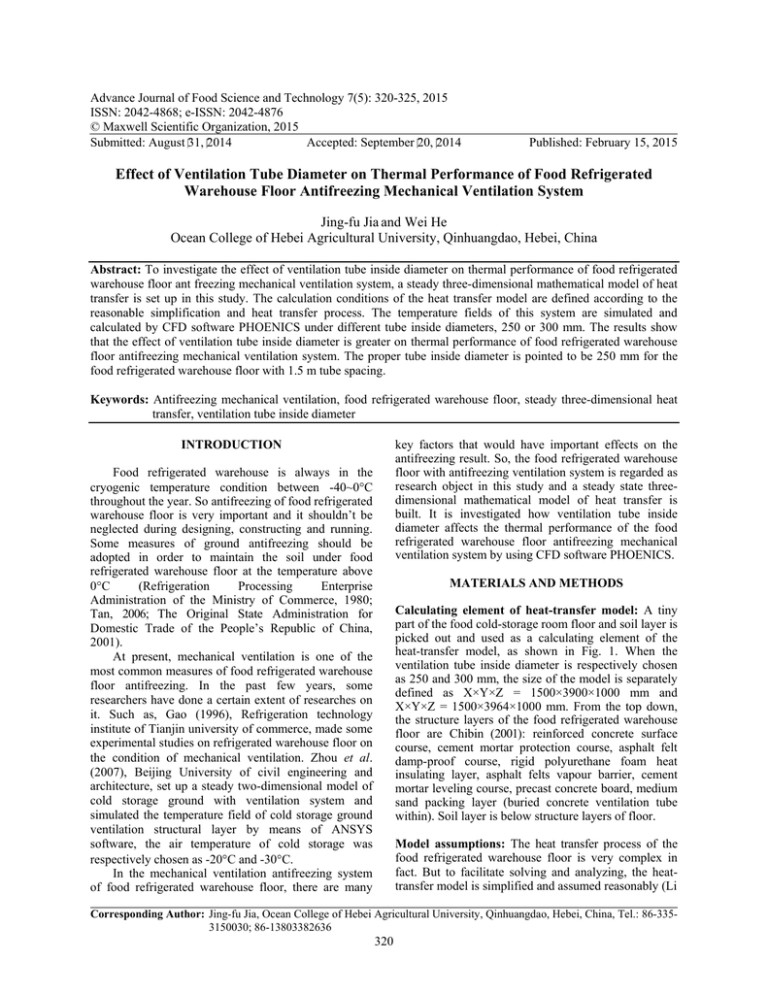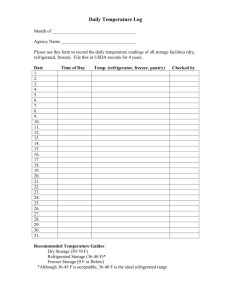Advance Journal of Food Science and Technology 7(5): 320-325, 2015
advertisement

Advance Journal of Food Science and Technology 7(5): 320-325, 2015 ISSN: 2042-4868; e-ISSN: 2042-4876 © Maxwell Scientific Organization, 2015 Submitted: August 31, 2014 Accepted: September 20, 2014 Published: February 15, 2015 Effect of Ventilation Tube Diameter on Thermal Performance of Food Refrigerated Warehouse Floor Antifreezing Mechanical Ventilation System Jing-fu Jia and Wei He Ocean College of Hebei Agricultural University, Qinhuangdao, Hebei, China Abstract: To investigate the effect of ventilation tube inside diameter on thermal performance of food refrigerated warehouse floor ant freezing mechanical ventilation system, a steady three-dimensional mathematical model of heat transfer is set up in this study. The calculation conditions of the heat transfer model are defined according to the reasonable simplification and heat transfer process. The temperature fields of this system are simulated and calculated by CFD software PHOENICS under different tube inside diameters, 250 or 300 mm. The results show that the effect of ventilation tube inside diameter is greater on thermal performance of food refrigerated warehouse floor antifreezing mechanical ventilation system. The proper tube inside diameter is pointed to be 250 mm for the food refrigerated warehouse floor with 1.5 m tube spacing. Keywords: Antifreezing mechanical ventilation, food refrigerated warehouse floor, steady three-dimensional heat transfer, ventilation tube inside diameter INTRODUCTION key factors that would have important effects on the antifreezing result. So, the food refrigerated warehouse floor with antifreezing ventilation system is regarded as research object in this study and a steady state threedimensional mathematical model of heat transfer is built. It is investigated how ventilation tube inside diameter affects the thermal performance of the food refrigerated warehouse floor antifreezing mechanical ventilation system by using CFD software PHOENICS. Food refrigerated warehouse is always in the cryogenic temperature condition between -40~0°C throughout the year. So antifreezing of food refrigerated warehouse floor is very important and it shouldn’t be neglected during designing, constructing and running. Some measures of ground antifreezing should be adopted in order to maintain the soil under food refrigerated warehouse floor at the temperature above 0°C (Refrigeration Processing Enterprise Administration of the Ministry of Commerce, 1980; Tan, 2006; The Original State Administration for Domestic Trade of the People’s Republic of China, 2001). At present, mechanical ventilation is one of the most common measures of food refrigerated warehouse floor antifreezing. In the past few years, some researchers have done a certain extent of researches on it. Such as, Gao (1996), Refrigeration technology institute of Tianjin university of commerce, made some experimental studies on refrigerated warehouse floor on the condition of mechanical ventilation. Zhou et al. (2007), Beijing University of civil engineering and architecture, set up a steady two-dimensional model of cold storage ground with ventilation system and simulated the temperature field of cold storage ground ventilation structural layer by means of ANSYS software, the air temperature of cold storage was respectively chosen as -20°C and -30°C. In the mechanical ventilation antifreezing system of food refrigerated warehouse floor, there are many MATERIALS AND METHODS Calculating element of heat-transfer model: A tiny part of the food cold-storage room floor and soil layer is picked out and used as a calculating element of the heat-transfer model, as shown in Fig. 1. When the ventilation tube inside diameter is respectively chosen as 250 and 300 mm, the size of the model is separately defined as X×Y×Z = 1500×3900×1000 mm and X×Y×Z = 1500×3964×1000 mm. From the top down, the structure layers of the food refrigerated warehouse floor are Chibin (2001): reinforced concrete surface course, cement mortar protection course, asphalt felt damp-proof course, rigid polyurethane foam heat insulating layer, asphalt felts vapour barrier, cement mortar leveling course, precast concrete board, medium sand packing layer (buried concrete ventilation tube within). Soil layer is below structure layers of floor. Model assumptions: The heat transfer process of the food refrigerated warehouse floor is very complex in fact. But to facilitate solving and analyzing, the heattransfer model is simplified and assumed reasonably (Li Corresponding Author: Jing-fu Jia, Ocean College of Hebei Agricultural University, Qinhuangdao, Hebei, China, Tel.: 86-3353150030; 86-13803382636 320 Adv. J. Food Sci. Technol., 7(5): 320-325, 2015 Fig. 1: The calculating element of heat transfer model for food refrigerated warehouse floor and Wang, 2003). These assumptions are as follows: Firstly, the heat transfer process of the food refrigerated warehouse floor is assumed to be a steady state heat conduction process of three-dimensional. Secondly, the materials in the same structural layer of the shipboard are assumed to be homogeneous, isotropic and with constant physical properties. Lastly, the thermal contact resistance between each layer, the thermal resistance of the asphalt felt layer and the moisture transfer are all assumed to be negligible. where, λ = The heat conduction coefficient of each kind of material (W/m·°C) t nb = The temperature of the upper surface of the coldstorage room floor (°C) The soil temperature is defined as: t s = 10.4°C. The soil temperature is derived from the minimum mean soil temperature of 3.2 m deep in Tianjin city in two months, March and April, over the years. So the boundary condition of the lower surface of the heattransfer model is: Equation and boundary conditions: The research object is the food refrigerated warehouse floor in Tianjin area of China in winter in this study. There is not heat source in the food refrigerated warehouse floor, so the steady state three-dimensional differential equation of heat conduction of the arithmetic element of the heat-transfer model may be described as follow: ∂ 2t ∂ 2t ∂ 2t + + =0 ∂x 2 ∂y 2 ∂z 2 t ∂t ∂y y = L2 = αn (t n − t nb ) = 12 × (− 20 − t nb ) (3) In the food refrigerated warehouse floor, ventilation tubes are symmetrically placed in terms of certain spacing in X-direction, so in the arithmetic element as shown in Fig. 1, the two boundary surfaces of the model in X-direction are approximately seemed as adiabatic surfaces and the boundaries are: (1) The boundary conditions of the arithmetic element are defined as follows: The design temperature of the cold-storage room floor is defined as: t n = -20°C. There are fan blowers in the cold-storage room, therefore the heat convective coefficient of the upper surface of the cold-storage room floor is defined as: a n = 12 W/m2·°C. So the boundary condition of the upper surface of the coldstorage room floor is: −λ = t s = 10.4 °C y= 0 ∂t ∂x x =0 = ∂t ∂x x = L1 =0 (4) Similarly, the two boundary surfaces of the model in Z-direction are also approximately seemed as adiabatic surfaces and the boundaries are: ∂t ∂z (2) 321 z =0 = ∂t ∂z z =1 =0 (5) Adv. J. Food Sci. Technol., 7(5): 320-325, 2015 The air supply velocity and temperature of ventilation tubes in the food refrigerated warehouse floor are defined as: v = 1.5 m/s, t in = 10°C. To ensure the thicknesses of medium sand packing layers between outside surface of concrete ventilation tube to upper surface of heating layer and outside surface of concrete ventilation tube to lower surface of heating layer are the same in the two different models, the inner diameter and outer diameter are respectively chosen as: d 1 = 250 mm and 300 mm, d 2 = 400 mm and 464 mm. The boundary conditions of outer surface of ventilation tube are all defined as: t = t w2 = t f + V ⋅ ρ ⋅ c p ⋅ (t out − t in ) d 1 1 + ln 2 ⋅ K ⋅ l K ⋅l 2πλ d1 c ^d, g ^ h , z ∈ (0,1) inside diameters, 250 or 300 and different thicknesses of medium sand packing layer, 400 or 464 and the other simulation conditions are not changed, numerical simulations of the heat-transfer model of the food refrigerated warehouse floor are performed using PHOENICS software. The obtained temperature distributions of the food refrigerated warehouse floor of the model in each case are shown in Fig. 2 and 3. The temperature distributions of lower surface for heating layer in each case are shown in Fig. 4 and 5. The temperature distribution curves of points on upper and lower surface for heating layer in each case are shown in Fig. 6 and 7. The temperature distribution curves of points at Z = 1m on lower surface for heating layer in each case are shown in Fig. 8. The obtained numerical results are shown in Fig. 2, 4 and 6 when ventilation system is circulating with 250 mm tube inside diameter. The average temperature of upper surface of heating layer is 1.290°C. The average temperature of lower surface of heating layer is 2.322°C. The temperature fluctuation amplitudes of each point at Z = 1m on upper surface of heat layer are 7.723°C (from -2.186 to 5.537°C). The temperature fluctuation amplitudes of each point at Z = 1m on lower surface of heat layer are 4.424°C (from 0.387 to 4.811°C). The average temperature of the surface at Z = 1m is 4.54°C. The obtained numerical results are shown in Fig. 3, 5 and 7 when ventilation system is circulating with 300 mm tube inside diameter. The average temperature of upper surface of heating layer is 2.118°C. The average temperature of lower surface of heating layer is 3.426°C. The temperature fluctuation amplitudes of each point at Z = 1m on upper surface of heat layer are 6.993°C (from -1.115 to 5.878°C). The temperature fluctuation amplitudes of each point at Z = 1m on lower surface of heat layer are 3.951°C (from 1.657 to x,y ∈ (6) where, t w2 tf = V ρ cp t out K l tin + tout 2 = The temperature of outer surface of ventilation tube (°C) = Mean air temperature of ventilation tube (°C) = The air flow of the system (m3/s) = The air density (kg/m3) = Specific heat at constant pressure of air (J/kg·°C) = The mean temperature of air at outlet of the system (°C) = The coefficient of heat-transfer between air and tube wall in ventilation tube on unit length (W/m·°C) = Total length of ventilation tube RESULTS AND DISCUSSION Simulation results of the heat-transfer model: When the ventilation system is circulating with different tube Fig. 2: The temperature field with 250 mm tube inside diameter 322 Adv. J. Food Sci. Technol., 7(5): 320-325, 2015 Fig. 3: The temperature field with 300 mm tube inside diameter Fig. 4: The temperature of lower surface for heating layer with 250 mm tube inside diameter Fig. 5: The temperature of lower surface for heating layer with 300 mm tube inside diameter 323 Adv. J. Food Sci. Technol., 7(5): 320-325, 2015 diameter is smaller, the temperature fluctuation amplitudes of points on upper and lower surface of heating layer are both bigger and the average temperatures of the upper and lower surface are both lower. On the contrary, the bigger the tube inside diameter is, the bigger the heat-exchange amount is, too and the cold energy transferred from food refrigerated warehouse floor to soil layer would be substantially reduced. For the higher temperature of the lower surface of heating layer, the moisture of soil can effectively prevent freezing. So the food refrigerated warehouse floor can avoid being frozen and humped. CONCLUSION Fig. 6: The point temperature of upper and lower surface for heating layer with 250 mm tube inside diameter Based on the established steady three-dimensional mathematical model of the food refrigerated warehouse floor, performing numerical simulations and analyzing the obtained temperature distributions, some conclusions are summarized as follows: Under the simulation conditions of this study, the lowest temperature of lower surface of heating layer in each case is respectively 0.387 and 1.657°C and the highest temperature in each case is respectively 4.811 and 5.608°C. So the average temperature of lower surface of heating layer in each case will be always above 0°C and the soil under heating layer will not be frozen for ever. The effectiveness of antifreezing in each case is better. Ventilation tube inside diameter has great influence both on the average temperature of upper and lower surface of heating layer and on the temperature distribution in the food refrigerated warehouse floor antifreezing ventilation system. When the other simulation conditions are not changed, the bigger the tube inside diameter is, the smaller the temperature fluctuation amplitudes of points in heating layer are, the higher the average temperatures of the of upper and lower surface of heating layer are and the better the effectiveness of food refrigerated warehouse floor antifreezing is. But these can cause the cost of tube to increase and the following increased ventilation quantity will cause the energy consumption of heat source to increase, too. At the same time, the higher temperature of heating layer will be bound to increase the cold load of food refrigerated warehouse. The result is that it will lead to more serious waste of energy and the storage quality of cargos near the cold storage ground will be affected. It is pointed that the better average temperature of heating layer is between 1 and 2°C (The Original State Administration for Domestic Trade of the People’s Republic of China, 2001). Doing like this, the requirement of antifreezing can be met and the consumption of heating energy can be cut down, too. Therefore, based on the simulation conditions and calculated results of this study, the proper tube inside Fig. 7: The point temperature of upper and lower surface for heating layer with 300 mm tube inside diameter Fig. 8: The point temperature of lower surface for heating layer with different tube inside diameter 5.608°C). The average temperature of the surface at Z = 1m is 4.826°C. Numerical results analyzing: In terms of the obtained temperature distribution figures shown in Fig. 2 to 8, the numerical results are analyzed. When tube inside 324 Adv. J. Food Sci. Technol., 7(5): 320-325, 2015 diameter is 250 mm for the food refrigerated warehouse floor with 1.5 m tube spacing. Li, J. and C. Wang, 2003. Refrigerating House Design. 1st Edn., China Machine Press, Beijing, pp: 1-42. Refrigeration Processing Enterprise Administration of the Ministry of Commerce, 1980. Refrigeration Technology for Cold Storage. 1st Edn., China Financial and Economic Publishing House, Beijing, pp: 236-264. Tan, X., 2006. Cold Storage Construction. 1st Edn., China Light Industry Press, Beijing, pp: 1-10. The Original State Administration for Domestic Trade of the People’s Republic of China, 2001. Code for Design of Cold Store. 1st Edn. China Planning Press, Beijing, pp: 1-64. Zhou, R., J. Chen, S. Wang et al., 2007. Numerical simulation on temperature field of ventilated ground structure layer of cold storage. Cold Storage Technol., 30(4): 37-40. ACKNOWLEDGMENT We kindly acknowledge financial support by the science and technology research and development Program of Qinhuangdao city (No.2012022A010). It is also important to note that these three authors contributed to this study equally and should be regarded as co-first authors. REFERENCES Chibin, Y., 2001. Practical Handbook of Refrigeration and Air-conditioning Engineering. 1st Edn., China Machine Press, Beijing, pp: 297-314. Gao, Z., 1996. Heat transfer calculation of the cold store mechanically ventilated for preventing the ground from frost heaving. Heat. Ventil. Air Cond., 26(4): 68-71. 325





